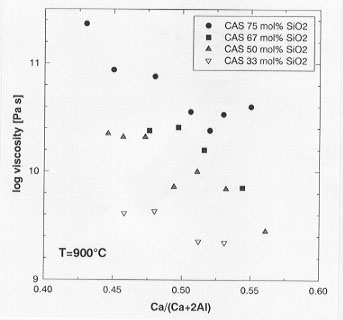

Unexpected variations in the composition-dependence of viscosity near the charge-balanced (tectosilicate stoichiometry) joins of alkaline-earth and alkali aluminosilicate melts have been demonstrated previously (Annual Reports 1995, 1996, 1997). Models developed for the interpretation of the structural origin of such variations contain the implication that the maxima in viscosity may shift in compositional position with temperature as the temperature dependence of various polyatomic species evolves. The viscosity of silicate melts in the system CaO-Al2O3-SiO2 (CAS) has therefore been measured in the high viscosity range using the micropenetration technique in order to complement existing low viscosity data. The composition of the samples along silica isopleths at 75, 67, 50 and 33 mol% SiO2 spans from the slightly peralkaline to slightly peraluminous fields. Previous measurements (Annual Report 1997) obtained by the concentric cylinder method (high temperature, low viscosity) revealed two viscosity maxima, one in the peralkaline, and the other in the peraluminous field. The latter has been explained by the presence of tricluster species (AlSi2O5.5) in the melt. In the high viscosity range, we have now observed a viscosity maximum for the peraluminous compositional field (Fig. 3.5-10) but no other maxima within the peralkaline field for the isopleth with 50 mol% silica. This is consistent with the trends exhibited by the high-temperature data, that this peralkaline maximum decreases with decreasing temperature. A potential explanation of the peralkaline maximum might be the presence of high coordinate aluminum in the melts. If so, its stability would be interpreted to decrease with decreasing temperature based on the present viscosity data.
 |
Fig. 3.5-10: Viscosities in the system CAS at 900°C versus the CaO content. 50% CaO corresponds to the charge-balanced join. Note that all curves show a clear maximum in the peraluminous field but none in the peralkaline field. |

Tel: +49-(0) 921 55 3700 / 3766, Fax: +49-(0) 921 55 3769, E-mail: bayerisches.geoinstitut(at)uni-bayreuth.de
 Previous page
Previous page